Tips and Tricks for an Organized Life
Figuring out what to do with all of your dogs things can be overwhelming. From leashes to toys, to medications and foods it can quickly become clear that your house is a dog house. We of course, want to acknowledge that there is a dog in our house, but there’s a fine line between it being a house with a dog in it or a dog’s house with you in it.
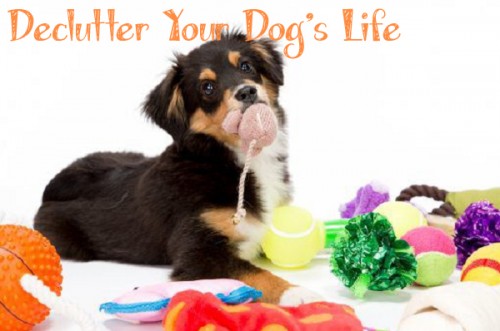
8 Clever Ways to Organize Your Dog’s Things:
Dog items with bonus space. Look for dog beds with a drawer underneath, pet steps with a lift-up step top, or elevated feeders with storage under the bowls. A dog Murphy bed saves floor space.
Double-duty furnishings. Assign toys to the space under an ottoman’s top, or keep dog towels in a bench with a lift-up seat.
Kitchen cabinets. Mount a spice rack under your over-counter cabinets to hold dog medications and supplements. Mount narrow shelves or hang an over-door shelf unit on the inside of cabinet doors.
Awkward spaces. Install a lazy Susan or pull-out storage unit to utilize cabinet corners.
Behind doors. Add a shoe organizer with pockets, a shelf unit, or rows of hooks. If you can’t install something on the door, use over-the-door hooks or organizers.
Underneath furniture. Hide gear in containers that fit under beds, sofas, and tables.
Walls. Hang wall pockets, or install shelves to host supplies in baskets. Use hooks or pegs for leashes.
Stored luggage. Between vacations, store out-of-season dog clothes and coats in suitcases.
“Look up, down, and think creatively,” Dansky adds.
Let’s talk toys. Among all of your dog’s things, toys can be the hardest to corral. If you leave them out they are likely to end up strewn across your floors, if you hide them away, your dog might not play with them at all. So how can you prevent dog toy clutter while still encouraging play?
6 Tips for Toy Clutter
Location, location, location. To find the right storage solution, first consider where your dog plays most, and look for storage options in that room. If your dog plays with Frisbee discs and balls outdoors, store those on the patio or covered deck for an immediate game of fetch.
Who, what, when. Then consider how your dog plays — does she play mostly alone or with you? What types of toys does she prefer, and how does she act with different kinds of toys? Does she need supervision with certain toys? Your answers will help you decide between using an open storage container with anytime dog access, or a closed or out-of-reach container so you control the toys she plays with.
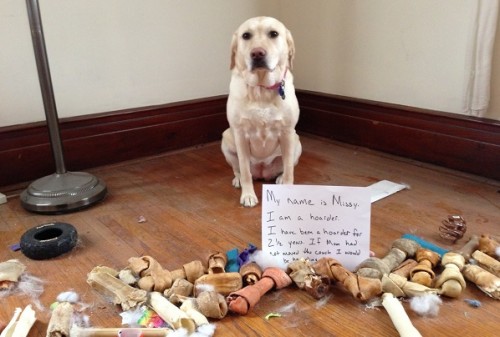
Decisions, decisions. To manage toys, you could provide your dog a choice among self-play toys like plush and squeaky toys, yet keep interactive-play toys like tug and tossing toys out of reach until you’re ready to play. You might reserve chew and treat toys for special occasions. Your storage will vary accordingly.
Rotate and remove. Your dog will accumulate more and more toys as time goes on, but likely will have a few favorites. He probably doesn’t need five balls and 10 squeaky toys. Store duplicate toys away and switch one or two of them out every few weeks to keep your dog interested and engaged. Remove old toys that have fallen apart or aren’t getting any attention and introduce other toys you’ve been storing away.
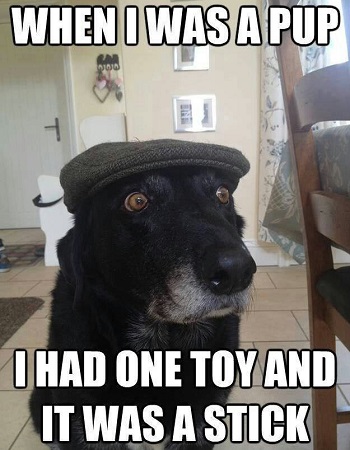
Getting Your Dog Used to Being Groomed
Zookeepers are well aware of the value of husbandry training for their animals. Animals in zoos often need to be weighed, have blood drawn, get their nails clipped, and various other maintenance activities. Gone are the days when animals are anesthetized or pressed into squeeze cages for this work. Now trainers teach the animals to stand quietly while their bodies are handled or medicated. Elephants open their mouths to have their teeth inspected, giraffes stand still on a weigh scale, and dolphins swim up and hold out their fins to have blood taken. How do trainers accomplish this? It’s actually quite simple. The animal is taught to climb on the weigh scale or present its ear for the reward of a treat. The behavior is well established without exposing the animal to any unpleasant experiences. An impressive example is the story of a diabetic baboon living in a California zoo. The baboon needed daily insulin shots but he was so aggressive, he had to be sedated each time. This was taking a toll on his health, because of both the sedative and the chronic stress. The zoo brought in animal trainer Gary Priest to see what could be accomplished. Progressing in very small steps, Gary was able to teach the baboon to extend his arm through the bars of the cage and grasp a bar while a technician applied alcohol to his arm, presented a needle, and applied a quick pinch. Eventually, the baboon was happy to go through the whole routine for his favorite reward. Several times a day, the procedure was repeated and, once a day, the baboon was given his insulin. To ensure the baboon’s continued cooperation, the number of mock injections had to be much greater than the number of real injections.
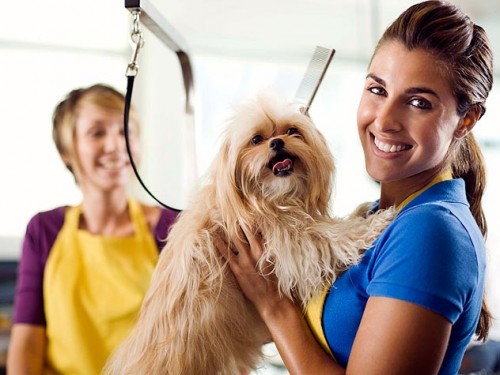
Two or three times a day, play “air” nail clipping. Have your puppy or dog sit and stay. Lift one paw and pretend to clip all the nails but just clip air! Do the same with all four feet. Once a day, clip ONE nail (only if they need it). Intersperse treats throughout. If you do this religiously, your dog will be well mannered and calm during nail clipping. Now, I don’t continue to do this throughout my dog’s life. Once you’ve established a solid foundation, your dog will only need occasional practice.
If your dog is already averse to nail clipping, you’ll have to break the procedure down to miniscule steps. You may have to start by just holding your dog’s paw and touching each nail, with the nail clippers sitting on a nearby table. Treat frequently. Once the dog is comfortable with this, hold the nail clippers in one hand, while holding the dog’s paw with the other. Next, “air clip” only one nail, give an amazing treat, and quit. Resist progressing until the dog is completely comfortable with the step you’re working on. Again, it’s advisable to do this when the dog is sleepy so you’ll meet with less resistance. Be patient – it can take months to reform an intractable nail “clippee”. If all else fails, trot your dog on pavement every day and your nail clipping activities will be restricted to his dewclaws!
Every dog is likely to need medication at some point in his life.
It’s a good idea to accustom your puppy to having his mouth handled so that you can give pills or liquid medicine. For this, I recommend the “baby bird” routine. You’ve probably seen how a baby bird opens its mouth wide to receive a meal from its parent. The baby trusts that food will end up in its mouth. You can teach your puppy to also expect a prize when you open his mouth. Hold the puppy in your lap and place one hand over the top of the puppy’s muzzle. Pry his jaw wide open. With the other hand, pull his bottom jaw down and place a tasty treat on his tongue. Release his mouth. He’ll immediately discover and eat the treat. Make sure you don’t place the treat so far back that the puppy might choke. Repeat numerous times. Pretty soon your puppy will welcome you handling his mouth and, if you occasionally stick a pill inside the treat, your puppy will be unlikely to notice. You may not ever need this training to successfully administer pills but it sure is handy if you have to give liquid medicine or poke around in there to retrieve a chicken bone.
Is there a better way to give pills? Dogs that love food are pretty easy to give pills – just hide the pill in a piece of cheese or wiener and the chowhound is happy to take his medicine. More discriminating dogs chew their food, detect the unwanted pill, and leave it lying on the kitchen floor. For these pill-savvy dogs, here’s a trick that often works. Teach the dog to catch treats tossed to him. Most dogs don’t bother to chew if you get them expecting to catch treats one after the other. On pill days, toss a series of yummy treats, with the pill hidden amongst them. Your dog will never suspect!
Be proactive with your dog. Teach him to enjoy all the things that will inevitably happen to him. He’ll be handled by groomers, poked and prodded by technicians, given needles by veterinarians. You’ll need to check his teeth, inspect his ears and eyes, clip his nails, and give him medication. None of these experiences are naturally pleasant for the dog so teach him to enjoy them. Your dog will be so much easier to care for if you do the foundation work.
Dog Skin Conditions: Superficial Bacterial Folliculitis
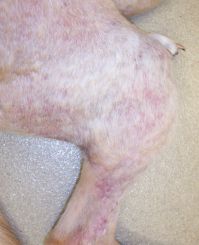
Photo courtesy David A. Senter, DVM
Cause: Most commonly, Staphylococcus (“staph”) bacteria, usually secondary to other skin disorders such as allergies, demodicosis (mange), endocrine problems, trauma, foreign bodies, and many others.
Symptoms: Shorthaired dogs often have patchy hair loss, tufts of hair raised above the coat surface and/or reddish or brown “staining” of white hairs. Longhaired dogs may have more subtle symptoms, including scaly skin, dull coat, and excessive shedding. Regardless of coat type, clipping may be necessary to fully reveal the extent of the disorder. The underlying skin lesions include bumps, pimples, crusts, or scales occurring singly, in clusters, or over large areas; reddened circular hairless areas with or without darker pigmentation in the center; scaly or crusty skin may surround the individual lesions in a circular pattern (epidermal collarettes). The degree of itchiness varies from intense to non-existent.
Treatment: Oral antibiotics for three to four weeks or longer, depending on the response; antibacterial shampoos; antibacterial ointments or sprays. Because superficial bacterial folliculitis occurs secondary to other disorders, identification and concurrent treatment of the underlying cause are essential for successful resolution.
Disclaimer: DogChannel.com’s Dog Skin Conditions are intended for educational purposes only. They are not meant to replace the expertise and experience of a professional veterinarian. Do not use the information presented here to make decisions about your dog’s ailment. If you notice changes in your dog’s health or behavior, please take your pet to the nearest veterinarian or an emergency pet clinic as soon as possible.
Deviled Doggie Eggs
Deviled eggs are a classic party snack for any occasion, but are always popular for football because of their resemblance to a football shape and of course are always a hit at Easter. With a few small adjustments, deviled eggs can quickly become doggie delights. Filled with protein, they make a healthy and grain-free treat for you and your furry friend. As with any treat, you will want to feed in moderation, especially if it’s your first time feeding a particular snack.

Eggs – as many as you like!
Plain, Unsweetened Yogurt – 1 Tbsp for every 2 eggs
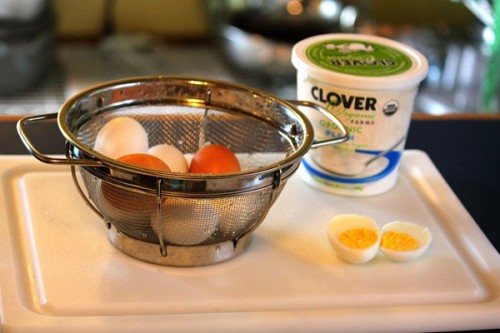
Hard boil your eggs. You can use any method you like, but this one worked for us
Put eggs in a pot and cover them with an inch of water.
Put a cover on the pot and bring the water to a boil.
Once boiling, remove the pot and let sit 15 minutes.
Run eggs under cold water and place in refrigerator to cool.
Once eggs are cooled peel and slice in half the long way.
Remove all of the yolks and place them in a bowl
Add yogurt (approximately 1 Tbsp for every 2 eggs) and mix until you get a creamy consistency.
Scoop mixture into the eggs, or if you want to be fancy, scoop mixture into a plastic bag. Cut the tip off of the bag and squeeze egg mixture back into the egg whites.




Types of Little Dog Breeds
Easygoing Small Dogs
Dogs large and small run the gamut in terms of temperament, although some are more mellow and easy going than others. Small canines who are known for having easygoing dispositions include Japanese chins, Shih Tzus, pugs, Chihuahuas and French bulldogs. If hyper dogs who are constantly on the go aren’t exactly your cup of tea, you might want to look into a pet from one of these breeds.
Lively Small Dogs
While some dogs are mellow and tranquil in nature, others are bundles of vitality and vigor. Small dogs who tend to have exuberant and bouncy natures include miniature pinschers, Cairn terriers and Yorkshire terriers. If spirited play sessions at the park and in your backyard are more your speed than cozy evenings in front of the television, then these small breeds might be most suited for you. In general, terriers are usually pretty tireless canines.
Small Dogs Who Love Other Dogs
Some dogs are eager to share in the company of their fellow canines, while others are more like loners — or they strongly prefer to be around human beings than other dogs. Certain small dog breeds are known to be more social in temperament than others. These breeds include Norfolk terriers, Cavalier King Charles spaniels and Havanese pooches. If you’re interested in a friendly small dog who doesn’t get too territorial or possessive around other animals, you just might find the canine of your dreams in one of these furry guys.
Fast Learning Small Dogs
Although properly and thoroughly training a dog isn’t always the easiest job, it has to be done. Some canines make the process a breeze, though. Small doggie breeds that are known for being training dreams include miniature poodles, papillons and Brussels griffons. Dog training typically involves everything from showing the furry cuties how to fetch to housebreaking them as puppies. Small dogs from these breeds often make those jobs easy, but remember, all dogs are individuals and some might be easier to train than others within these breeds.
Benefits of Little Dogs
When considering what kind of dog to add to your home, become familiar with all the ins and outs of the specific breed. Several advantages exist with dogs from smaller breeds. Tinier dogs tend to lead longer lives. They often can manage in smaller living environments better than larger dogs. Transporting them from one place to another also is often a simpler task, whether your destination is the groomer or the vet.
People Who Adopt Dogs & Then Get Rid of Them
According to the American Society for the Prevention of Cruelty to Animals (ASPCA) and studies reported in the Journal of Applied Animal Welfare Science, 20 percent of dogs in shelters were adopted from shelters. The adopters returned their pets for a variety of reasons, most having to do with behavior problems, conflicts between the new pet and in-home pets or a problem between the owner’s children and the new pet. Have a question? Get an answer from a Vet now!
Behavioral Problems
Almost a third–28 percent–of pet owners who return their pets do so because of a behavior problem. Many shelter dogs end up in the shelter because of behavior issues, only to be adopted out again–and returned again–for the same issues. Problems such as destructive behavior, inappropriate elimination, aggression, excessive barking, escaping, and other unwanted behaviors can lead to the owner’s dissatisfaction, and the dog’s return to the shelter. Some owners are unwilling or unable to correct their new dog’s behavior problems and return the animal. In many cases either the owners were not informed of the dog’s behaviors, or they held different expectations.
Conflicts Between Pets
Of the pet owners returning their dogs to the shelter, 19 percent cited that the dog did not get along with the other pets in the household. Bringing a new dog into a household of other pets often disturbs the hierarchy established by the other pets. The owner will often shower attention on the new addition to the dismay of the current pets, thus causing strife between them. Dogs will often behave differently at a shelter than in a household, so it is difficult to judge if the new dog will fit in.
Conflicts Between Dog and Children
One problem that causes dogs to be returned to the shelter are conflicts with the child or children in the household. These conflicts ranged from the children stressing the dog to the dog being too rambunctious for the children. Around 15 percent of owners returned their pets for this reason, and 4 percent of owners expected their children to care for the pet. In these cases, the shelter failed to match the family to the appropriate pet.
Other Reasons
Other reasons for shelter returns include that the dog got too large, the owner or family member had an allergic reaction, the dog had a health issue or the owner didn’t have enough time to spend with the pet.
Reduction of Dog Returns
Most returns occur from a failed set of expectations. The adopter often has a skewed perception of pet ownership and the role a dog plays in it. To reduce returns, shelters need to educate their potential adopters better as well as screen the people looking to adopt a pet. If the shelter educates the new pet owner on what to expect in the dog’s behavior, health, and cost, the pet owner may be able to make an informed decision regarding the pet they adopt.
Spend Quality Time with Your Dog
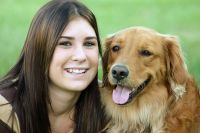
The dog’s owner is a busy guy. He’s got a full-time job, a house to maintain, and all the other tasks to perform that go with life today. I sympathize: 21st century life can be chaotic for anyone. But we can make time for our dogs without exerting very much effort or spending a lot of extra time. Here are some ways to do just that.
Take her along. Whether running errands, picking the kids up from school, or stopping by your office, including your dog can be a hassle-free way to give her attention and stimulation. “For adult dogs whose owners’ lifestyles primarily revolve around being home, at soccer games, and ferrying the kids to school, having the dog participate in these activities can meet much of her social needs,” says Alice Moon-Fanelli, Ph.D., certified applied animal behaviorist at the Cummings School of Veterinary Medicine at Tufts University.
Sleep with her. Experts agree that having your dog sleep in your bedroom, but not necessarily on your bed, can be a great way to spend extended time with your canine companion with no additional effort on your part. You sleep, she sleeps. What could be easier?
Find things you both like to do. Some activities you do for your own enjoyment are even more fun if your four-legged friend does them with you. Moon-Fanelli recommends spending some one-on-one time with your dog “in mutually enjoyable physical activities,” such as swimming and hiking.
Try multi-tasking. Are you busy fixing lunch or preparing dinner while your dog hangs around? Use this opportunity to help her practice sit-stays and down-stays. Are you watching TV? Use that time to brush your best friend, too — or at least give her some cuddle-time.
Do some delegating. If you don’t live alone, other family members can help out with dog care. For example, “when there are children in the household, they can become the designated walkers, exercisers, and players,” notes Terry Curtis, DVM, veterinary behaviorist at the University of Florida in Gainesville. “It just spreads the interactions over more people.”
That said, you do need to at least spend a little extra time with your dog if she’s to become a happy member of your household and stay that way. Every dog needs training, exercise, and some one-on-one time with her people each day. A little creativity on your part can go a long way toward meeting those needs without putting much of a dent in your schedule.





